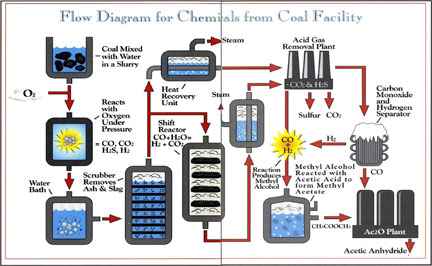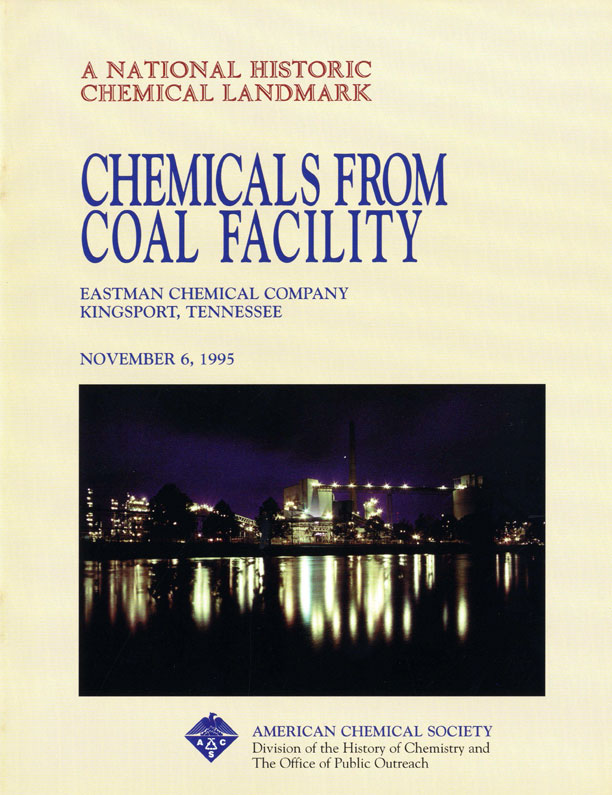Acetyl Chemicals from Coal Gasification
Dedicated November 6, 1995, at Eastman Chemical Company in Kingsport, Tennessee.
The Chemicals from Coal Facility of Eastman Chemical Company was the first in the United States to use coal rather than petroleum as a raw material in the commercial production of acetyl chemicals — important building blocks in the synthesis of a wide range of consumer products. The plant, located in Kingsport, Tennessee, began operation in 1983 after more than a decade of planning and construction, prompted by the oil embargoes of the 1970s. By substituting locally available, high-sulfur coal, this process conserves petroleum previously required for the production of these high-volume chemicals.
Contents
Chemicals from Coal
For centuries, people have been making useful products by performing chemical reactions with natural substances — everything from manufacturing glass from sand to converting wood to methanol, acetic acid, and charcoal. Throughout the years, coal has been an important natural resource in the manufacture of chemical products.
Liquid coal tar products were first obtained from coal in England during the 1700s and were used in shipbuilding. Lamp oil was produced from coal in the U.S. as early as 1850. In the late 1800s, fuel gas and metallurgical coke were made in Germany. The resulting tar by-products were refined and used around the world as aromatics for pharmaceuticals, dyes, explosives, and photographic chemicals. World War I and Germany's embargo of aromatic coal tar products — particularly toluene needed for TNT — resulted in the development of the U.S. domestic coal chemicals industry.
Throughout the 20th century, coal was converted to gases or liquids, which typically were reacted with carbon monoxide in the presence of catalysts to form methanol or related simple molecules. The coal gases or liquids could also be cracked to give olefins and acetylenes, which were then used to produce other organic chemicals.
Most recently, coal gasification technologies like those used by Eastman have been employed to produce chemical feedstocks, the building blocks from which complex chemicals like plastics, fibers, dyes, and other consumer products are constructed. Eastman was the first company in the U.S. to produce a new generation of industrial chemicals commercially using coal gasification technology.
During the 1930s, coal was used as a principal raw material in the production of 60 percent of organic materials, while petroleum was used in only 10 percent. By 1960, the proportions were reversed. Due to the availability of vast new supplies of crude petroleum and the introduction of improved refining techniques, petroleum and natural gas now supplied more than 80 percent of all industrial organic chemicals, while coal was the source of only 20 percent of organic chemicals.
In 1973, a boycott by Arab members of the Organization of Petroleum Exporting Countries (OPEC) triggered petroleum shortages in the U.S. and a surge in the price of crude oil from $3 to $30 a barrel. While the American public endured long lines at the gas pumps, the chemical industry's production of industrial organic chemicals was hampered.
Eastman Creates Acetic Chemicals from Coal
In the years leading up to the oil embargo, the chemical process industries expanded their energy conservation programs and began a search for lower-cost chemical feedstocks. In 1970, Eastman scientists conducted a prescient planning study that considered solutions for a critical set of circumstances. The company was heavily dependent on petroleum and natural gas as raw materials for the manufacture of key chemicals, particularly acetic anhydride. The supply of oil worldwide, especially in the U.S., was finite and rapidly diminishing. Based on its intrinsic value, petroleum — which was then only selling for only a few dollars a barrel — was significantly under priced. The cost of oil would increase and, given certain circumstances, could skyrocket drastically.
The 1970 study projected that coal would become a more attractive energy source than oil and an important chemical feedstock. Located in the heart of the Appalachian coalfields, the company was in a unique position to utilize this abundant, economical resource.
The events of 1973 caused Eastman to recognize the immediate need for a commercially feasible means of synthesizing critical high-volume chemicals such as acetic anhydride from raw materials other than petroleum. Acetic anhydride, at the time derived from petroleum feedstocks, had earlier been identified as a key product Eastman could produce using coal. Eastman consumes more than one billion pounds of acetic anhydride annually in cellulosic plastics, filter products, textile yarns, and in the production of photographic film. Active research and development on a coal-based anhydride process, initiated in 1975, eventually involved several hundred employees from several departments. The first small pilot plants began operation in 1977.
The Texaco Coal Gasification Process was selected to be the source of synthesis gas, a combination of carbon monoxide and hydrogen that is suitable for conversion into more complex chemicals. The process was specifically designed to use coal from the nearby Virginia coalfields. Oxygen and a coal/water slurry are introduced into the gasifier under conditions of high temperature and pressure, which produces the synthesis gas in a specific carbon monoxide-to-hydrogen ratio. A portion of the gas from the gasifier is sent to a "shift" reactor to increase the hydrogen content.
The two product gas streams from the gasifier — the shifted gas and the raw synthesis gas — are purified in a number of steps. The hydrogen sulfide and carbon dioxide are removed using the Linde AG Rectisol process. The hydrogen sulfide is converted to elemental sulfur using a Claus process followed by a Shell Claus off-gas treating unit, resulting in 99.7 percent of the sulfur originally in the coal being recovered and sold as a co-product of the operation. Carbon dioxide is also recovered and sold to make carbonated beverages. The purified raw synthesis gas stream is then sent to a "cold box" and cryogenically separated into hydrogen and carbon monoxide using Linde AG technology. The hydrogen is mixed with the shifted gas and sent to the methanol plant, and the carbon monoxide is used for acetic anhydride production.
Methanol is produced using a catalytic gas-phase reactor developed by Lurgi AG. The proper gas feed composition for methanol production is obtained by combining the hydrogen-enriched gas from the shift reactor with the hydrogen gas stream from the gas separation unit.
Using a reactive distillation process developed at Eastman, methanol made from the synthesis gas reacts with acetic acid, a co-product from cellulose esters manufacturing, to form methyl acetate. In the final step, which uses an Eastman proprietary catalyst system and process, purified carbon monoxide from the gas separation plant reacts with methyl acetate to form acetic anhydride. Methanol is also added to the anhydride process to co-produce acetic acid.
The development of the acetic anhydride reactor configuration was the main engineering issue in the process development. Two pilot plants were constructed and operated with several reactor designs to evaluate competing schemes. Designs for evaporators, vacuum distillation columns, and control schemes were based on computer simulations with some assistance from pilot plant testing.
Eastman Opens the Chemicals from Coal Facility
Before construction of the actual facility could begin, the 55-acre site had to be elevated above the 100-year floodplain of the Holston River. More than 500,000 cubic yards of fill dirt were used to raise the area where the facility would stand.
Construction began in July 1980 and continued for nearly three years, with more than 2,600 workers employed at the peak of the building project. The original facility required more than 6,000 tons of structural steel, 27,000 cubic yards of concrete, 1 million feet of pipe and conduit, and 10,000 miles of electrical and instrument wire.
Coal grinding and slurry operations began in March 1983, and the methyl acetate plant started in May. The first of two gasifiers was fired on June 19, and methanol production began one month later. Acetic anhydride production began on October 6, 1983, and the desired product quality was achieved almost immediately. During the first nine months of operation, the gasifiers operated more than 85 percent of the time, and the acetic anhydride and methyl acetate units operated more than 75 percent of the time.
During a scheduled maintenance shutdown in July of the following year, several process improvements identified during the initial operation were implemented. Since that time, additional improvements have enabled the facility to produce acetic anhydride more than 97 percent of the time.
The energy efficient, environmentally responsible Chemicals from Coal Facility gasifies about 1,150 tons of high-sulfur coal per day produced from nearby Virginia mines. This conserves the equivalent of some 1.5 million barrels of oil annually. In addition, the facility recovers 99.7 percent of the sulfur contained in the coal for sale to the sulfuric acid industry. Carbon dioxide generated from the gasification process is also collected, treated, and sold for use in carbonated beverages.
The facility doubled in size after an expansion was completed in 1991 and currently employs about 300 people.

Eastman Chemical Company: Future and Past
The Chemicals from Coal Facility maked Eastman the first U.S. manufacturer to produce a modern generation of industrial chemicals from coal. The project has resulted in new methods for engineering design, new materials for high-temperature applications, and new mechanical maintenance methods. More importantly, the innovative process provides potential routes for using synthesis gas to produce other chemicals from coal, further reducing U.S. dependency on foreign petroleum.
Today, coal gasification can be used to gasify not only the conventional feedstocks, but also various wastes such as asphaltenes, petroleum coke, sewage sludge, and used tires and oils to produce electrical power and chemicals. Using the knowledge gained from the existing complex, Eastman researchers are working on a new and more economical carbonylation route to new building-block chemicals from coal.
Eastman Chemical Company traces its beginnings to the early 1900s when George Eastman was searching for a methanol supplier for the cellulose acetate-based photographic chemicals that were central to Eastman Kodak Company's business. Kodak's dependence on European suppliers had become all too apparent during World War I, and Eastman was determined to find an alternative. In Kingsport, Tennessee, he found an abandoned wood-distillation plant originally established to supply methanol and other chemicals for the federal government. The abundance of trees in this area assured Eastman of a ready supply of raw materials, and he purchased the vacant plant in 1920. Five decades later, the same business strategy that led Eastman to make Kodak independent of European sources of the chemicals critical to his photographic process motivated Eastman Chemical Company to begin research into chemicals from coal. Eastman Chemical Company operated as a division of Kodak for 73 years before becoming an independent, publicly owned company on January 1, 1994.
Landmark Designation and Acknowledgments
Landmark Designation
The American Chemical Society designated the Chemicals from Coal Facility as a National Historic Chemical Landmark in a ceremony at Eastman Chemical Company in Kingsport, Tennessee, on November 6, 1995. The plaque commemorating the event reads:
This plant was the first in the United States to use coal rather than petroleum as a raw material in the commercial production of acetyl chemicals – important building blocks in the synthesis of a wide range of consumer products, including plastics, textile fibers, and photographic film. The plant came on stream in 1983, following eight years of research and process development in coal gasification and related technology prompted by the oil embargoes of the 1970s. An expansion project in 1991 doubled the original capacity. By substituting locally available, high-sulfur coal, this process conserves the equivalent of 1.5 million barrels of oil per year previously required for the production of these high-volume chemicals.
Acknowledgments
Adapted for the internet from “Chemicals from Coal Facility,” produced by Eastman Chemical Company for the National Historic Chemical Landmarks program of the American Chemical Society in 1995.
Back to National Historic Chemical Landmarks Main Page
Learn more: About the Landmarks Program
Take action: Nominate a Landmark and Contact the NHCL Coordinator


